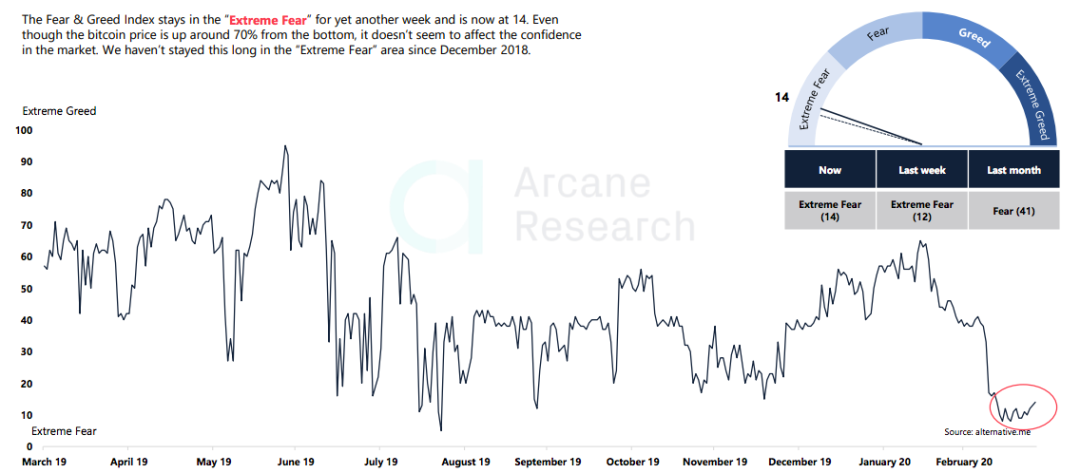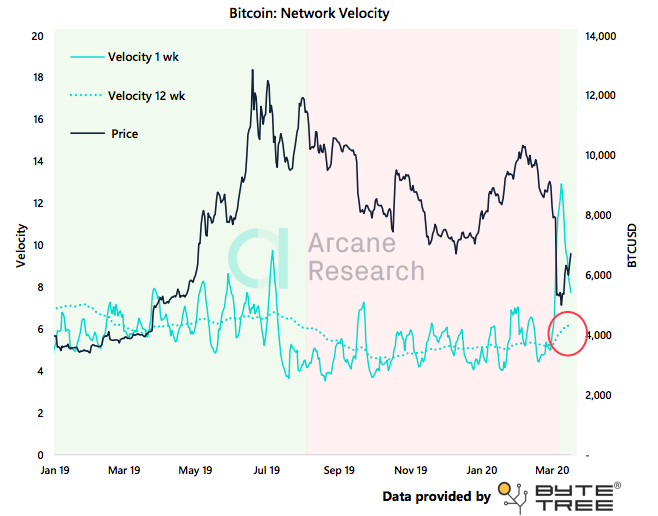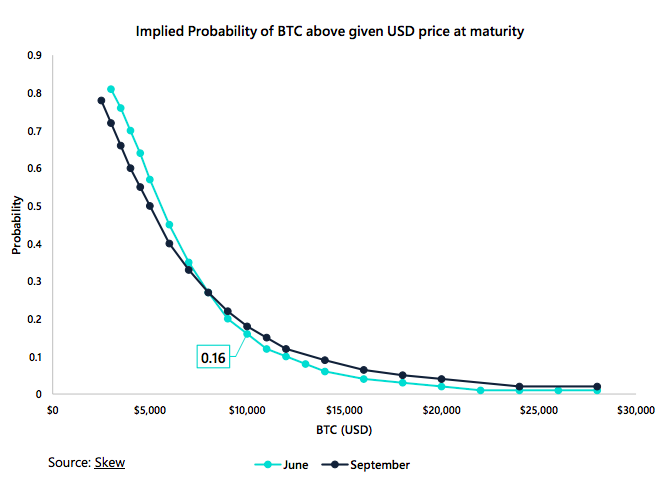The data shows that the probability of BTC breaking through 10,000 in June is only 16%. Do you believe it?
As Bitcoin continues to fluctuate significantly, people also tend to look for more reliable "value discovery" logic from many interpretations.
As a data-based research institution, Arcane Research also analyzes the "recovery situation" of Bitcoin since the "12 March" plunge from the aspects of macroeconomics, transactions, and on-chain data, and also looks for the next one. Possible "rising points". Its core points are as follows:
- After rising by 70%, currency users still cannot get rid of "extreme fear";
- Forward price spreads indicate a bearish market;
- Currency price volatility has reached its annual peak and will continue;
- BTC turnover rate gets rid of the trough, or brings the possibility of rising;
- Prediction: The probability of BTC surpassing $ 10,000 in June is only 16%.
 After rising by 70%, currency users are still "extremely scared"
After rising by 70%, currency users are still "extremely scared"
We often hear the daily fear and greed index, but I am afraid that only by looking at the cycle length can we really understand the meaning of this data.
- Research report | When the blockchain meets the sharing economy, what kind of spark will it collide with?
- Shanghai court first explores the use of blockchain certificate technology, and 10 court trial trial record reforms started in April
- The blockchain industry's air outlet is reappearing: dozens of institutions quietly lay out the Shanghai Lingang Free Trade Zone, and the four provinces are intensively issuing policies to grab the "track"
The figure below shows Bitcoin's index of fear and greed over the past year, and the ordinate from bottom to top represents from extreme fear to extreme greed.
 Source: Alternative
Source: Alternative
As can be seen from the figure, "extreme fear" has only occurred twice a year. The first occurred in early August last year. Bitcoin experienced a sharp rise and fall, so the market experienced extremely short-term extreme fear.
This is the second week after the "March 12" plunge. Although the price of Bitcoin has risen by about 70% from its lowest point, it has not fundamentally reversed the market's confidence. For two weeks, the fear and greed index were 12 and 14, respectively, and they are still in extreme fear.
Such a long period of panic also appeared in December 2018. At that time, Bitcoin halved in one month and fell all the way to the bottom range of $ 3,200. This shows on the side that for current market participants, Bitcoin 3800-6000 USD is the lowest value of their psychological expectations.
Odaily Planet Daily Note: The panic index threshold is 0-100. The impact factors include: volatility (25%), market transaction volume (25%), social media popularity (15%), market research (15%), Proportion in the entire market (10%) and Google Hotwords Analysis (10%).
 Forward price spread indicates bearish market
Forward price spread indicates bearish market
The "3 · 12" plunge has brought two significant changes to the bitcoin futures market: one is the plunge in trading volume; the other is the abnormal phenomenon that the futures transaction price is lower than its underlying spot.
Skew data shows that the open positions of BitMEX's XBT / USD (Bitcoin) perpetual contract fell to 55,000 BTC, a record low in 18 months. According to data from TokenAnalyst, the number of Bitcoins withdrawn from BitMEX in the past two weeks exceeded the number of Bitcoins deposited, resulting in a net outflow of 67,000 Bitcoins from the platform.
The futures trading volume reflects the sluggish trading atmosphere in the contract market and the market's main force temporarily suspended. In the traditional stock market, the inverse spread of stock index futures relative to the spot index is a signal that the stock market is bearish. As a result, Arcane Research said that this may not be a good sign for Bitcoin.
 Before the plunge, June and September BTC futures prices were higher than spot prices, and now they are reversed
Before the plunge, June and September BTC futures prices were higher than spot prices, and now they are reversed
But such markets do not lack opportunities for arbitrage. Arcane Research points out that this is good news for bulls looking to open positions, which means they can return the premium of futures prices relatively easily.
 Currency price volatility has reached its annual peak and will continue
Currency price volatility has reached its annual peak and will continue
A major reason for contract players to leave the market is the current high volatility of Bitcoin.
From the data of Cryptowat.ch, the 30-day volatility of the Bitcoin price has reached its highest level in a year, and currently exceeds 9%. The higher the volatility, the more uncertain the return on assets.
Arcane Research pointed out that under the systemic risk of global economic turmoil, the price trend of bitcoin will still be difficult to stabilize in the future, so it is recommended that market participants should exercise caution.
 Source: cryptowat.ch
Source: cryptowat.ch
 BTC turnover rate gets rid of trough, or it may bring rise
BTC turnover rate gets rid of trough, or it may bring rise
Arcane Research also introduced us to a less common but interesting metric: Velocity (Bitcoin Network Speed), the data comes from Bytetree, an institution that monitors this metric for a long time.
The Bitcoin network rate refers to the speed at which Bitcoin changes hands. The observation period is once every 12 weeks, and the unit is 0-2000%. If the rate of Bitcoin is 1000% in 12 weeks, it means that Bitcoin is circulating 10 times a year; high network speed means that Bitcoin is circulating faster and the market situation is better.
According to Bytetree statistics, only five times since 2013 have encountered "historical danger levels" with a rate of less than 600%: March 30, 2014, August 1, 2018, March 13, 2019, and 2019 August 20-Last week.
Usually, low rates often lead to price drops. Fortunately, just last week, we can see that Bitcoin has come out of a low rate of 600%. Arcane Research believes that this may be a bullish signal, indicating that Bitcoin is moving a lot and playing a positive role in financing effect.

 Prediction: The probability of BTC breaking 10,000 in June is only 16%?
Prediction: The probability of BTC breaking 10,000 in June is only 16%?
According to data from Skew markets, on March 29, the Put / Call ratio for bitcoin options contracts reached 1.10, the highest level since March 13.
In traditional financial markets, Put / Call ratios above the 0.7-1 range indicate that short pressure is significant, as traders are more likely to sell rather than buy. There may be many reasons for this selling pressure, the most important of which is the expectation of falling prices.
Before the "March 12" plunge, this ratio once surged to 1.39, the highest level in the past 3 months; two days after reaching 1.39, the spot price of Bitcoin dropped from $ 7,800 to less than $ 4,000. At the same time, Bitcoin's Put / Call ratio also dropped below 1.08.
So far, this ratio has risen again to 1.10, which may mean that Bitcoin's price outlook is not optimistic.

In addition, according to Skew data, the prices of various options platforms indicate that by the end of June 2020, the probability of BTC breaking through $ 10,000 is only 16%, while the probability of falling below $ 5,000 is as high as 80%.
However, using the option price to predict the target price is difficult to say that it works in the traditional financial market, not to mention the digital currency market that is not yet mature in the financial derivatives market. So let's just laugh at this data.
We will continue to update Blocking; if you have any questions or suggestions, please contact us!
Was this article helpful?
93 out of 132 found this helpful
Related articles
- Perspectives | Ethereum 2020: Roadmap and Outlook
- Opinion | Wang Qian of Jilin University: The Central Bank will definitely face fierce competition between private and fiat currencies in the future
- Prediction | Data show that the probability of BTC breaking 10,000 by June is only 16%
- Embarrassing or strange new narratives: Bitcoin is to money, like 0 to mathematics
- Industry Blockchain Weekly News 丨 Listed companies enter annual report season, blockchain becomes a key word
- Babbitt Column | Interpretation of the French Central Bank's Digital Currency Experiment: Open Cooperation Institution Recruitment officially launched in the third quarter
- Babbitt weekly selection 丨 US $ 6 trillion stimulus policy favors Bitcoin; how important is blockchain in China's tens of trillions of "new infrastructure"?






